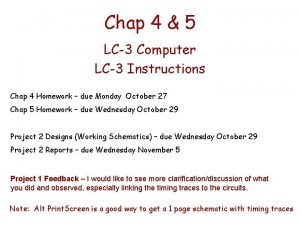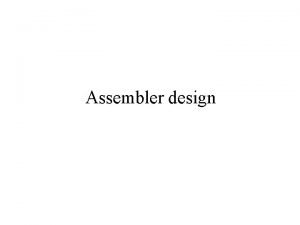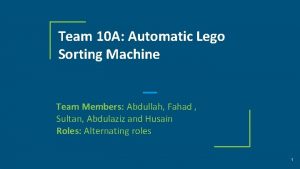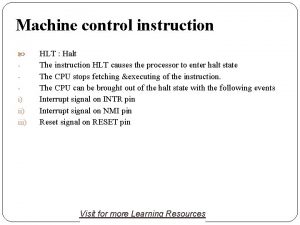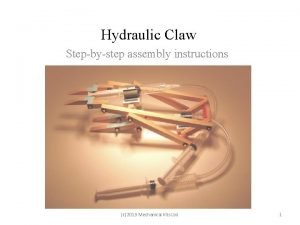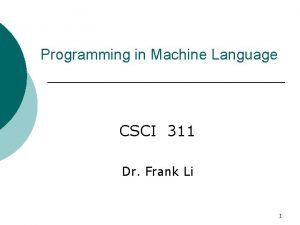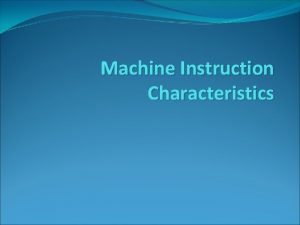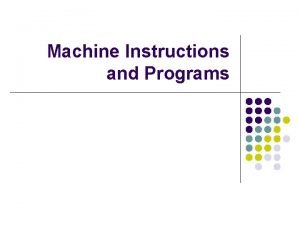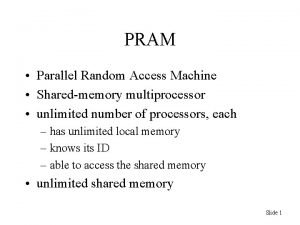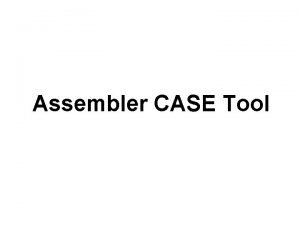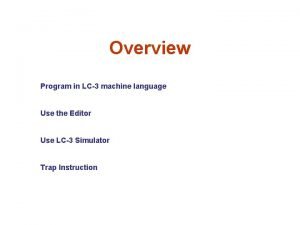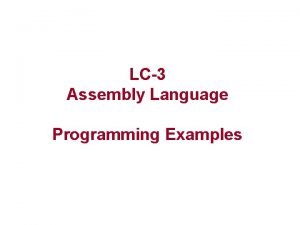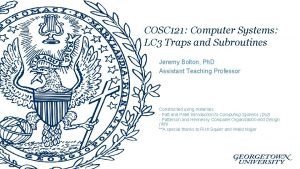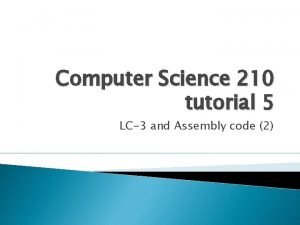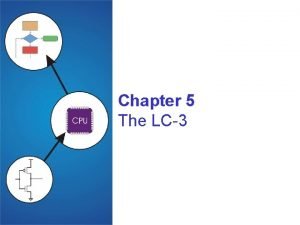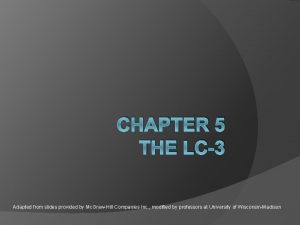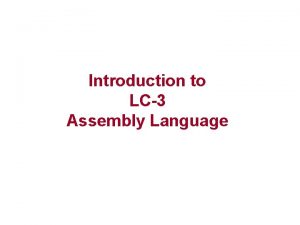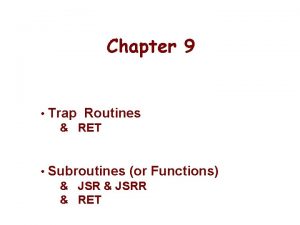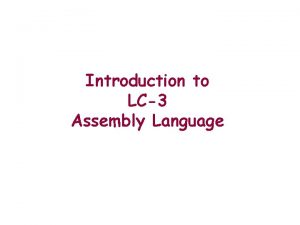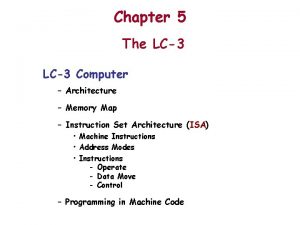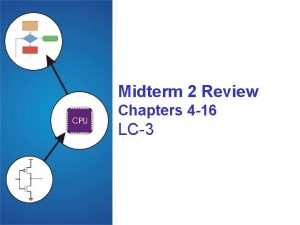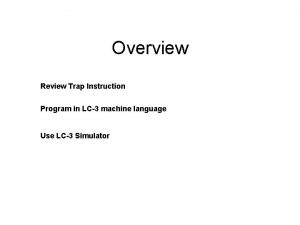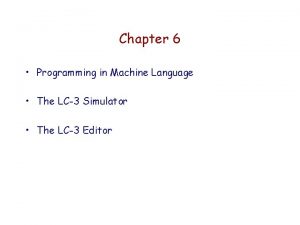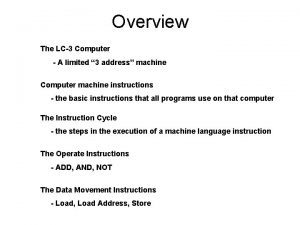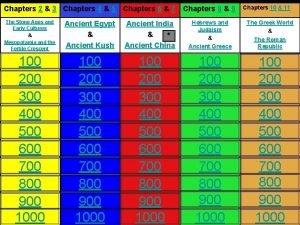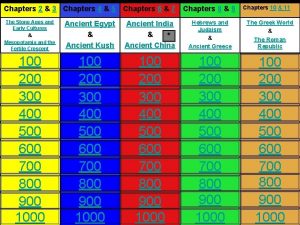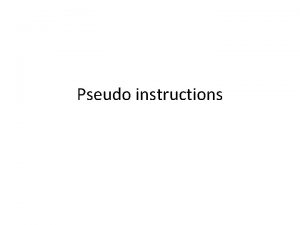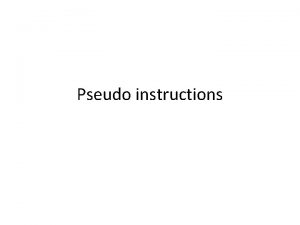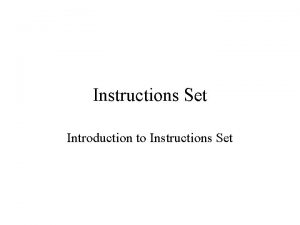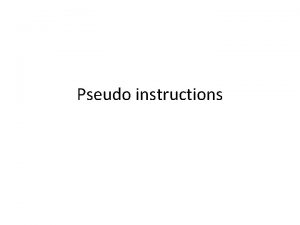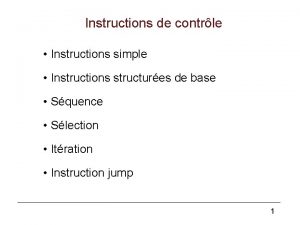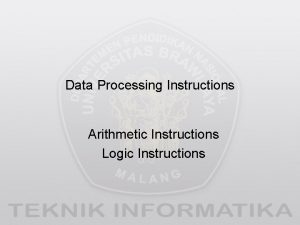Chapters 4 5 LC3 Computer Architecture Machine Instructions























![Branch Instruction BR [0000 nzp PCoffset 9] • Branch specifies one or more condition Branch Instruction BR [0000 nzp PCoffset 9] • Branch specifies one or more condition](https://slidetodoc.com/presentation_image_h2/9529fc05554a8acdf26798ff7f197b64/image-24.jpg)

![Jump Instruction JMP Base. R [1100 000 Base. R 000000] • Jump is an Jump Instruction JMP Base. R [1100 000 Base. R 000000] • Jump is an](https://slidetodoc.com/presentation_image_h2/9529fc05554a8acdf26798ff7f197b64/image-26.jpg)





- Slides: 31

Chapters 4 & 5: LC-3 Computer • Architecture • Machine Instructions • Assembly language • Programming in Machine and Assembly Language

Overview The LC-3 Computer 16 bit machine, word addressable, 64 K or 65, 536 locations Computer Machine Instructions – Computer “native” instructions - The basic instructions that all programs use on that computer (The “atomic” unit of work done by a computer) The Instruction Cycle - The steps in the execution of a machine language instruction (Fetch, Decode, Evaluate Address(es), Fetch operand(s), Execute, and Store results)

LC-3 Data Path: Combinational Logic Storage State Machine

Data Path of the LC-3

LC-3 Memory Layout x 0000 – x 2 FFF System: Operating System programs, tables, and data - Generally off limits to programmer (Programs run in Supervisor mode) x 3000 – x. FDFF User: User Program and Data Area shared by users like you (Nominally run in non-supervisor mode) x. FE 00 – x. FFFF Device: I/O Register Addresses Pseudo memory used for input/output R 0 -R 7 Registers (16 bit)

LC-3 Memory Map

Computer Machine Instruction Formats What is IN an instruction? • Operation code – what to do • Input Operand(s) – where to get input operands (memory, registers) • Output Operand(s) – Where to put results (memory, registers) What are the major instruction types? • Data Movement (load, store, etc. ) • Operate (add, sub, mult, OR, AND, etc. ) • Control (branch, jump to subroutine, etc. )

The Instruction Cycle Steps (or phases): • Fetch Next Instruction from Memory (PC) (points to) next instruction PC (PC) + 1 • Decode Fetched Instruction • Evaluate Address (es) (find where the data is) • Fetch Operand (s) (get data) • Execute Operation • Store Result (if specified)

The LC-3 Instruction Addressing Modes • Register (Operand is in one of the 8 registers) • PC-relative (Operand is “offset” from the (PC) ) • Base + Offset (Base relative) (Operand is “offset” from the contents of a register) • Immediate (Operand is in the instruction) • Indirect (The “Operand” actually points to the real address – rather than being the operand)

The LC-3 Instruction Addressing Modes • Register (Operand is in one of the 8 registers) • Immediate (Operand is in the instruction) • PC-relative (Operand is “offset” from the (PC) ) • Indirect (The “Operand” actually points to the real address – rather than being the operand) • Base + Offset (Base relative) (Operand is “offset” from the contents of a register) Note: no Direct Addressing defined in the LC-3

LC-3 Instructions (Fig 5. 3 – Appendix a)

Operate Instructions • Only three operations: ADD, AND, NOT • Source and Destination operands are: Registers

ADD/AND (Register)

NOT (Register) Note: Src and Dst could be the same register.

ADD/AND (Immediate) Note: Immediate field is sign-extended.

Data Movement Instructions • Load -- read data from memory to register – LD: – LDI: – LDR: PC-relative mode indirect mode base+offset mode [0010 DR PCoffset 9] [1010 DR PCoffset 9] [0110 DR Base. R offset 6] • Store -- write data from register to memory – ST: – STI: – STR: PC-relative mode indirect mode base+offset mode [0011 DR PCoffset 9] [1011 DR PCoffset 9] [0111 DR Base. R offset 6] • Load effective address – address saved in register – LEA: immediate mode [1110 DR PCoffset 9]

LD (PC-Relative)

ST (PC-Relative)

LDI (Indirect)

STI (Indirect)

LDR (Base+Offset)

STR (Base+Offset)

LEA (Immediate)
![Branch Instruction BR 0000 nzp PCoffset 9 Branch specifies one or more condition Branch Instruction BR [0000 nzp PCoffset 9] • Branch specifies one or more condition](https://slidetodoc.com/presentation_image_h2/9529fc05554a8acdf26798ff7f197b64/image-24.jpg)
Branch Instruction BR [0000 nzp PCoffset 9] • Branch specifies one or more condition codes • If the set bit is specified, the branch is taken: – PC is set to the address specified in the instruction – Target address is made by adding SEXT(IR[8: 0]) to the PC • If the branch is not taken: - the next sequential instruction (PC) is executed.

BR /////// + SEXT
![Jump Instruction JMP Base R 1100 000 Base R 000000 Jump is an Jump Instruction JMP Base. R [1100 000 Base. R 000000] • Jump is an](https://slidetodoc.com/presentation_image_h2/9529fc05554a8acdf26798ff7f197b64/image-26.jpg)
Jump Instruction JMP Base. R [1100 000 Base. R 000000] • Jump is an unconditional branch -- always taken. • Base – Address is contents of the register – Allows any target address.

TRAP • Calls a service routine, identified by 8 -bit “trap vector. ” vector routine x 23 input a character from the keyboard x 21 output a character to the monitor x 25 halt the program • When routine is done, PC is set to the instruction following TRAP.

TRAPS

Using Branch Instructions • Compute sum of 12 integers. Numbers start at location x 3100. Program starts at location x 3000. R 1 x 3100 R 3 0 R 2 12 R 2=0? NO R 4 R 3 R 1 R 2 M[R 1] R 3+R 4 R 1+1 R 2 -1 YES R 3: Accumulator for the sum of integers R 1: Array index pointer (Begin with location 3100) R 4: Temporary register to store next integer R 2: Loop counter (Count down from 12)

Sample Program Address Instruction Comments x 3000 1 1 1 0 0 0 1 1 1 1 1 R 1 x 3100 (PC+0 x. FF) x 3001 0 1 0 1 1 1 0 0 0 R 3 0 x 3002 0 1 0 1 0 1 0 0 0 R 2 0 x 3003 0 0 0 1 0 1 0 1 1 0 0 R 2 12 x 3004 0 0 0 1 0 0 0 0 1 If Z, goto x 300 A (PC+5) x 3005 0 1 1 0 0 0 0 1 0 0 0 Load next value to R 4 x 3006 0 0 0 1 1 0 0 0 1 Add to R 3 x 3007 0 0 0 1 1 0 0 1 Increment R 1 (pointer) X 3008 0 0 0 1 0 1 1 1 1 Decrement R 2 (counter) x 3009 0 0 1 1 1 1 1 0 Goto x 3004 (PC-6)

Example 1: Multiply • This program multiplies two unsigned integers in R 4 and R 5. clear R 2 add R 4 to R 2 decrement R 5 No R 5 = 0? Yes HALT x 3200 x 3201 x 3202 x 3203 x 3204 01010100000 00010100100 0001101101111111 000001111101 1111000000100101 R 2 <- 0 R 2 <- R 2 + R 4 R 5 <- R 5 – 1 BRzp x 3201 HALT
 Ldr lc3
Ldr lc3 Pseudo instructions in computer architecture
Pseudo instructions in computer architecture Lc3 architecture
Lc3 architecture Lc3 opcodes
Lc3 opcodes Hypothetical machine in computer architecture
Hypothetical machine in computer architecture Three bus architecture
Three bus architecture Difference between computer organization and architecture
Difference between computer organization and architecture Complete computer description in computer organization
Complete computer description in computer organization Lego sorting robot
Lego sorting robot Jump instruction
Jump instruction Hydraulic claw machine
Hydraulic claw machine Brookshear machine
Brookshear machine What is a machine instruction?
What is a machine instruction? Machine instructions
Machine instructions In random access machine, instructions are executed
In random access machine, instructions are executed Basic computer instructions
Basic computer instructions Optical discs store items by using microscopic
Optical discs store items by using microscopic Instructions language of the computer
Instructions language of the computer Lmc instruction set
Lmc instruction set Which industry almost exclusively uses micr?
Which industry almost exclusively uses micr? Multiplication in lc3
Multiplication in lc3 Lc3 assembly language tutorial
Lc3 assembly language tutorial Cosc 121
Cosc 121 Lc3 assembly language tutorial
Lc3 assembly language tutorial Lc3 isa
Lc3 isa Nop instruction
Nop instruction Lc3 datapath
Lc3 datapath Symbol table lc3
Symbol table lc3 Trap vector table lc3
Trap vector table lc3 Hp netserver lc3
Hp netserver lc3 Finite state machine vending machine example
Finite state machine vending machine example Mealy or moore machine
Mealy or moore machine
